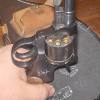Cosmoline
Member

Well that was what I call an advanced handloading exercise! Oy. I was using Fiocchi once fired brass and the Lee hybrid die set that's primarily set for .32-20. The die set sells on Midway and is something of a work in progress. Here are the steps I went through to do it:
1--Run spent Fiocchi shells through the deprimer/resizer die. Usually this is a really, really easy step. But the Lee die seems excessively narrow and reforms the brass about as much as any die I've ever seen I needed to use considerable amount of case lube on the shell and inside the die to keep it from getting stuck.
1a--Get the right shellholder! The Lee shellholder that comes with the set will not fit Fiocchi 7.62 Nagant. Instead I scrounged up an RCBS No. 1, for the .308, which by a very odd circumstance fits the Nagant OK. Not perfect, but good enough if you use a hand press and take your time.
2--Run through the neck expander, using ample amounts of lube and being real careful. It will look way too expanded.
3--Reprime, again using the RCBS No. 1 shellholder and a hand primer. Make sure the primers go all the way in and are not just flush.
4--Charge (I use 4 grains of Unique) and drop the bullet in. It should go quite far in with minimal or no pressure. I used .309" Hornady HP/XTP 90 grainers.
5--Seat the bullet. Here's the beauty part, where I fell into a simple and effective solution to the problem. A Hornady bullet from an earlier abortive seating attempt had gotten stuck a little bit. No big deal, but then I got to thinking. What if I just leave it lie? So I did, and I'll be darned if that bullet didn't act as a perfect little extension and seat the actual bullets just right, a notch below the case mouth. Very, very little pressure is needed here, and if you use too much it's easy to destroy the case. I found that out the hard way.
6--Run through the resizer again. You must first remove the decapper pin assembly, of course. This is the really weird step, unique to this die set AFAIK, and I got two cases in a row jammed in there and getting them out was a little hard on the nerves, since they're primed live rounds at that point. After that I thought about it for a moment and decided a full length resize is a waste of time and causes too many problems. So I just did a half length resize, to close up the mouth a bit and get it so it will work in the revolver. Again use care and do NOT attempt to ram it over the bullet or it will jam up. The goal is to shrink down the mouth and create a slight taper from the bullet to the forcing cone, so that the brass will slip inside and form that unique Nagant seal.
There you have it. I'm trying them tomorrow. According to the data collected by others before me on the Nagant forum, they should run out at about 1,000 fps. It's a little shy of the old military Nagant loads, and if I see no pressure sign I'll probably take it up to 4.5 grains and 1,100 fps for the next batch.




